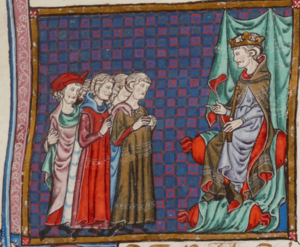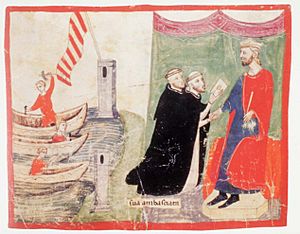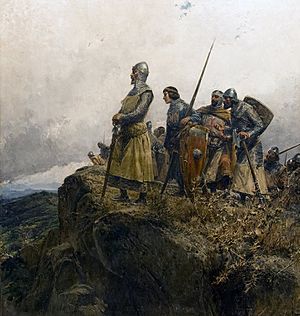Peter III of Aragon facts for kids
Quick facts for kids Peter III |
|
|---|---|
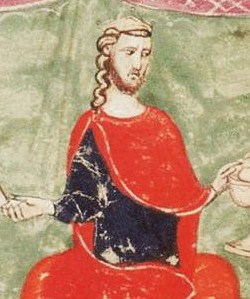
Detail from the Nuova Cronica
|
|
| King of Aragon and Valencia Count of Barcelona |
|
| Reign | 27 July 1276 – November 1285 |
| Predecessor | James I |
| Successor | Alfonso III |
| King of Sicily (jure uxoris) | |
| Reign | 4 September 1282 – November 1285 |
| Predecessor | Charles I |
| Successor | James I |
| Co-ruler | Constance II of Sicily |
| Born | c. 1239 Valencia, Aragon |
| Died | November 1285 (aged 45–46) Vilafranca del Penedès, Aragon |
| Burial | Santes Creus |
| Consort | Constance II of Sicily |
| Issue | Alfonso III of Aragon James II of Aragon Elizabeth, Queen of Portugal Frederick III of Sicily Yolande, Duchess of Calabria Peter of Aragon |
| House | Barcelona |
| Father | James I of Aragon |
| Mother | Violant of Hungary |
| Religion | Roman Catholicism |
Peter III of Aragon (around 1239 – November 1285) was the King of Aragon, King of Valencia (as Peter I), and Count of Barcelona (as Peter II) from 1276 until his death. He became King of Sicily in 1282. He took the throne of Sicily after people there asked for his help. His wife, Constance II of Sicily, had a strong claim to the Sicilian throne. This united Sicily with the Crown of Aragon.
Contents
Becoming King: Peter's Early Life and Reign
Peter was the oldest son of James I of Aragon and his second wife, Violant of Hungary. When he was young, Peter gained a lot of military experience. He fought in his father's wars against the Moors during the Reconquista.
In June 1275, Peter faced a challenge from his half-brother, Fernando Sánchez de Castro. Peter defeated him at Pomar de Cinca.
When his father died in 1276, the lands of the Crown of Aragon were split between Peter and his younger brother. Peter, as the oldest, received the Kingdom of Aragon, the Kingdom of Valencia, and the Catalan counties. His brother, James II of Majorca, received the Kingdom of Majorca and other Catalan lands.
Peter and Constance were crowned in Zaragoza in November 1276. The archbishop of Tarragona led the ceremony.
Early Challenges and Rebellions
Peter's first task as king was to bring peace to his Valencian lands. This work had started before his father passed away.
However, a rebellion soon began in Catalonia. It was led by powerful nobles like the viscount of Cardona. These nobles had issues with Peter's strict rule when he was still a prince. They also complained that he did not call the Catalan Courts or confirm their special rights after he became king.
There was also a problem in the County of Urgell. When its count died, his family members fought over who would inherit the land. Peter's father had taken control of some of this county, and Peter inherited it. In 1278, Ermengol X, the count's oldest son, got most of his land back. He then agreed to recognize Peter as his ruler.
In 1280, Peter put down the rebellion led by Roger-Bernard III. He besieged the rebels in Balaguer for a month. Many rebel leaders were put in prison until 1281. Roger-Bernard stayed in prison until 1284.
Wars in Other Lands
Campaign in Tunisia
In 1277, the ruler of Tunisia, who had been under the rule of Peter's father, died. Tunisia then broke away from Aragon. Peter sent an army to Tunis in 1280 to bring it back under his control. In 1281, he prepared a large fleet of 140 ships with 15,000 men to invade Tunisia. The fleet landed in 1282. It was here that Peter received a message from Sicily. The Sicilians asked him to become their king.
The Sicilian Vespers War
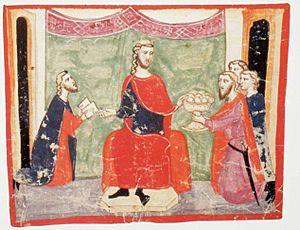
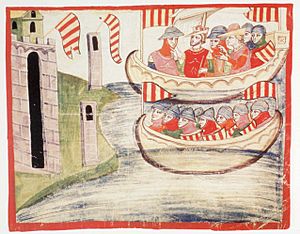
In 1266, Charles I of Naples took over the Kingdom of Sicily. This kingdom was ruled by the Hohenstaufen family, which was Peter's wife's family. Peter's wife, Constance II of Sicily, was the rightful heir to Sicily. Her father, Manfred, and her cousin had died fighting Charles. This made Peter the heir to Sicily through his wife.
An Italian doctor named John of Procida worked for Peter in Sicily. John had fled to Aragon after Charles took over. John traveled to Sicily to encourage people to support Peter. He then went to Constantinople to get help from Michael VIII Palaiologos. Michael would not help without the Pope's approval. So, John went to Rome and got the approval of Pope Nicholas III. This Pope was worried about Charles's growing power. John then returned to Barcelona. However, Pope Nicholas died, and a new Pope, Pope Martin IV, was chosen. This new Pope was French and a strong supporter of Charles. This set the stage for a big conflict.
Constance claimed her father's throne, with Peter's support. But Charles had the Pope's backing and was very powerful. The election of a new Pope, Pope Nicholas III, in 1277 gave Peter some hope. But Nicholas died in 1280, and the pro-French Pope Martin IV became Pope, ending Peter's hopes for papal support.
Despite this, Peter started making important alliances with nearby rulers. He made his brother James II of Majorca sign a treaty in 1279. This treaty recognized the Kingdom of Majorca as a feudal kingdom under Peter III. This made the Crown of Aragon a strong, united realm. Peter also made alliances with the Kingdom of Castile in 1281. He signed treaties with Alfonso X of Castile and Sancho.
Peter also formed a family alliance with the Kingdom of Portugal. His oldest daughter, Elizabeth of Aragon, married Denis I of Portugal. He also made an alliance with the Kingdom of England. His heir, Alfonso III, was engaged to Eleanor of England, daughter of Edward I of England. Even with these alliances, Peter's relationship with France remained difficult.
On March 30, 1282, a popular uprising happened in Sicily. It was called the Sicilian Vespers. The people rebelled against Charles I of Anjou's rule. The Sicilian nobles asked Peter for help. They offered him the crown because they saw his wife Constance as their rightful Queen. After receiving a message from the people of Palermo, Peter landed at Trapani on August 30, 1282. He was declared King in Palermo on September 4. Charles was forced to leave Sicily. Pope Martin IV then excommunicated both Peter and Michael VIII Palaiologos.
Peter's ground troops were led by Guillem Galceran de Cartellà. These troops included the famous and feared almogavars, who were skilled fighters. Peter's strong fleet was commanded by Roger of Lauria. This fleet successfully stopped Charles's attacks on the island. Roger de Lauria defeated the French forces in the Battle of Malta and at the Bay of Naples in 1284.
The conquest of Sicily was paid for by collecting money and taxes. The Kingdom of Sicily became a very important part of the Aragonese royal family's lands for the next five centuries.
Troubles at Home
Peter was dealing with problems at home while the French were planning to invade Aragon. He took Albarracín from the rebellious noble Juan Núñez de Lara. He also renewed his alliance with Sancho IV of Castile. He attacked Tudela to try and stop Philip I of Navarre from invading from that side. Peter held meetings of the cortes (parliament) in Tarragona and Zaragoza in 1283. He was forced to grant the Privilegio General to the new Union of Aragon.
Also in 1283, Peter's brother James II of Majorca joined the French. This gave the French easy passage into Catalonia through Roussillon. It also gave them access to the Balearic Islands. In October, Peter began preparing Catalonia's defenses. In 1284, Pope Martin IV gave the Kingdom of Aragon to Charles, Count of Valois. Charles was another son of the French king. The Pope approved a war to conquer Aragon for Charles of Valois.
The Aragonese Crusade
In 1284, the first French armies, led by Philip and Charles, entered Roussillon. They had a huge army of 16,000 cavalry, 17,000 crossbowmen, and 100,000 infantry. They also had 100 ships. Even though the French had James's support, the local people fought against them. The city of Elne was bravely defended. Eventually, the city was taken, and the cathedral was burned. The French forces continued their advance.
In 1285, Philip set up camp outside Girona to besiege it. The city resisted strongly, but it was eventually captured. Charles was crowned there, but without a real crown. However, the French soon faced a setback. Roger of Lauria returned from Italy and defeated the French fleet. The French fleet was destroyed at the Battle of Les Formigues on September 4, 1285. Also, a disease spread through the French camp.
The King of France himself became sick. The King of Navarre, who was next in line for the French throne, started talks with Peter. He wanted safe passage for the royal family through the Pyrenees mountains. But the French troops were not given this passage. Many of them were defeated at the Battle of the Col de Panissars. Philip III of France died in October in Perpignan. James II of Majorca, who had fled in fear, was declared a vassal of Peter.
Peter's Love for Arts and Poetry
Peter was like his father in supporting arts and literature. But unlike his father, Peter loved poetry, not just prose. He supported the troubadours, who were poets and musicians. Peter himself wrote two sirventesos, which are types of poems. One was a conversation between him and another troubadour. The other was part of a collection of five poems.
The wars with Philip III of France and James II of Majorca also inspired new sirventesos. During this time, these poems became a way to spread political messages. Each side could use them to present their case and gain support.
Death and What Came Next
Peter died from unknown causes in Vilafranca del Penedès in November 1285. This was just one month after Philip III of France died. Peter was buried in the Monastery of Santes Creus. Before he died, he said that his conquests were for his family's claims, not against the church. His body is in a porphyry stone coffin at the monastery.
Like his father, Peter divided his kingdoms among his sons. He left Aragon to his oldest son, Alfonso III. He left Sicily to his second son, James II. Peter's third son, Frederick, later became regent of Sicily and then its king.
In the famous poem Divine Comedy, the writer Dante Alighieri sees Peter "singing in agreement" with his old rival, Charles I of Anjou. They are outside the gates of Purgatory.
Peter's Children
Peter and Constance II of Sicily had six children:
- Alfonso III of Aragon (November 4, 1265 – June 18, 1291).
- James II of Aragon (August 10, 1267 – November 2, 1327).
- Elizabeth, Queen of Portugal (around 1271 – July 4, 1336). She married Denis of Portugal.
- Frederick III of Sicily (December 13, 1272 – June 25, 1337).
- Yolande, Duchess of Calabria (around 1273 – August 1302). She married Robert of Naples.
- Peter of Aragon (around 1275 – August 25, 1296). He married Guillemette of Béarn.
Peter also had children with Ines Zapata between 1275 and 1280:
- Fernando of Aragon.
- Sancho of Aragon.
- Pedro of Aragon. He married Constança Mendes da Silva in Portugal.
- Teresa of Aragon.
Additionally, he had 3 children with Maria Nicolau before marrying Constance of Sicily:
- Jaime Perez of Aragon (died 1285).
- Juan Perez of Aragon.
- Beatriz of Aragon (died 1316).
See also
 In Spanish: Pedro III de Aragón para niños
In Spanish: Pedro III de Aragón para niños


